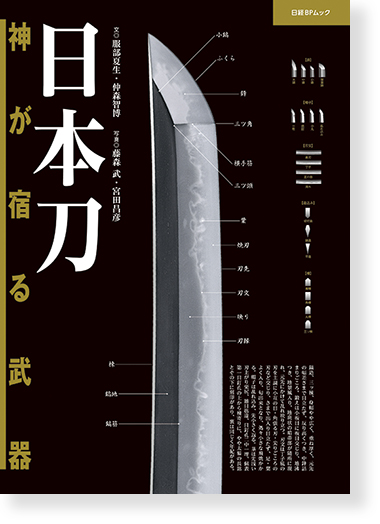
HOME | BOOKS | AUTHORS | GENRES | CONTACT
Natsuo Hattori & Tomohiro Nakamori - The Japanese Sword
The Sacred Weapon of God
Jump to: Book details | About the authors | Table of contents
 |
The Japanese sword is said to have the hardest blade in the world. It is a weapon as well as a piece of art, sometimes admired as a sacred treasure.
The book looks back the history of Japanese sword thatoriginated from the Heian period (from 794 to 1185 a.d.), dives into the secrets of its astonishing features, and unveils the complete process of Japanese sword-making by Kunihira Kawachi, one of the best swordsmiths of our time. Vivid photographs depict the scenes of selecting Tamahagane steel, forging, hot forming, and polishing (kajioshi).
|
Natsuo Hattori - Editor, Writer
Born in Nagoya, Aichi Prefecture in 1973, Natsuo Hattori graduated from Tohoku University with a degree in English Literature and began working for a publishing company in 1996, where he also served as editor-in-chief of cutlery magazines and mooks. As a writer, he has written and serialized articles in magazines and newspapers such as Nikkei Technology Online, National Geographic, Hitotoki, and the Tokyo Shimbun in the fields of traditional crafts and organic life, in addition to cutlery and iron-related topics. His publications include Uchihamono Shokunin (with photos from Hisaaki Mihara, World Photo Press). Books he has produced and edited include Chiyotsuru Korehide: Works and Life of a Blacksmith Who Embodies Japanese Hand Tool Culture and Cutlery Compendium (both published by World Photo Press), and Hakaru, Shiru, Kurasu (published by Kodomo Mirai Keisokusho).
Tomohiro Nakamori - General Manager, Nikkei BP Future Research Institute, Nikkei BP, Inc. - Executive Officer
Tomohiro Nakamori was born in 1959. He joined Oki Electric Industry in 1984, where he was engaged in research on thin-film materials at the Fundamental Technology Research Laboratory. He joined Nikkei BP in 1989 and served as editor-in-chief of Nikkei Mechanical and Nikkei BizTech before assuming his current position in 2013. He is also a visiting professor at the Waseda University Research Institute. He is the co-author of Developer Biographies (co-authored, Nikkei BP, Inc.), Side Effects of Speculation (2010, Nikkei BP, Inc.), FUKUSHIMA Report: The Essence of the Nuclear Accident (co-authored, Nikkei BP Consulting, Inc.), and Automatic Operation (co-authored, Nikkei BP, Inc.) He has also done a lot of work in the field of Japanese culture and traditional crafts, including Honmono no Nihonjin (Nikkei BP, Inc.) and Gino no Kokoro (Nikkei Technology Online, Inc.)
Takeshi Fujimori - Photographer
Born in Tokyo in 1942, Takeshi Fujimori graduated from Tokyo College of Photography (now Tokyo Polytechnic University). After studying under photographer Ken Domon, he began freelancing in 1970 and mainly focuses on Japanese cultural traditions such as antiques and Buddhist statues. He also continues to photograph the collections of over 90 museums throughout Japan. His photo collections include Koma: The World of Kumagai Moriichi (Kodansha), Hibutsu: The Eleven-Faced Kannon (Heibonsha), Hidden Buddhas (5 volumes; Tokyo Bijutsu), Nata-bori Arabori: Mysterious Wood Carved Buddhas (Tamagawa University Press), Gozaru: Kyogenji Nomura Mansaku no Gei (Kodansha), and Yanagi Muneyoshi Collection: Beauty for Use (first and second volumes; Sekai Bunka Sha). He co-authored with Masako Shirasu of Masako Shirasu: My Antiques (Kyuryudo) and Flower Diary (Sekaibunka-sha). Takeshi Fujimori is a member of the Japan Professional Photographers Society, and the director and curator of the Ken Domon Memorial Museum.
Masahiko Miyata - Photographer
Born in Ibaraki City, Osaka in 1963, Masahiko Miyata graduated from the Department of Photography, Osaka University of Arts. He has been a freelance photographer since 1991 and runs M2 Photo, a company that handles advertising photography. Has been photographing swordsmith Kunihira Kawachi since 1997 and continues to do so. His solo exhibitions include "Under the Dote of the Tenjo River" (Gallery Beni, Contax Gallery, 1994) and "The World of Kunihira Kawachi, the Sword Master" (HANARE, Fuji Photo Salon, 2005). He is the author of Glico's Toys (Shinpusha), The Life of Kunihira Kawachi, the Sword Master (Ribun Shuppan), The Charm of the Japanese Sword (Ribun Shuppan), and Gi: Kishiwada Old City Danjiri Festival (You Time Publishing). He is a member of the Japan Advertising Photographers Society, a lecturer at Osaka University of Arts, and a photography instructor at Nikon College.
Chapter 1: The most powerful and beautiful weapon
Chapter 2: The unsolved mystery of Tamahagane steel
Chapter 3: Forging steel for ultimate beauty
Chapter 4: Things more important than secret techniques
Chapter 5: Beyond the best
Chapter 6: Facing the legacy while challenging the new era
Appendix: The 50 Best Japanese Swords